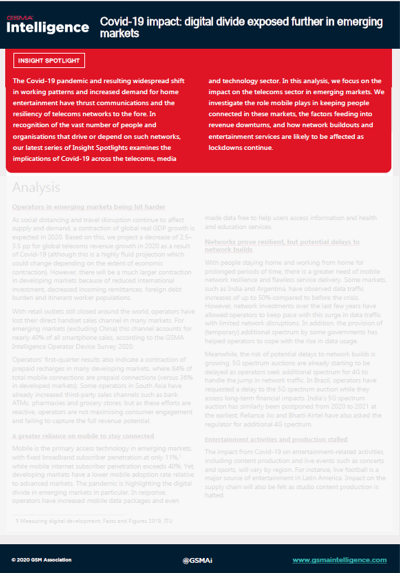Covid-19 impact: digital divide exposed further in emerging markets

This insight is available to those subscribed to the Mobile Operators and Networks module.
Report details
Covid-19 impact: digital divide exposed further in emerging markets
The Covid-19 pandemic and resulting widespread shift in working patterns and increased demand for home entertainment have thrust communications and the resiliency of telecoms networks to the fore. In recognition of the vast number of people and organisations that drive or depend on such networks, our latest series of Insight Spotlights examines the implications of Covid-19 across the telecoms, media and technology sector. In this analysis, we focus on the impact on the telecoms sector in emerging markets. We investigate the role mobile plays in keeping people connected in these markets, the factors feeding into revenue downturns, and how network buildouts and entertainment services are likely to be affected as lockdowns continue.
Report details
Covid-19 impact: digital divide exposed further in emerging markets
Related research
5G and network transformation: five trends to watch in 2026
How will the industry evolve in 2026? This series of reports highlights the key trends to watch and the implications for ecosystem players. This report examines 5G and network transformation.
GSMA Open Gateway: State of the Market, H2 2025
In the latest edition of the GSMA Open Gateway research series, key developments for H2 2025 include the segmentation of industry demand, and the continued deployment of APIs in categories other than fraud and security. The report provides an update on the state of the market, recent developments and examples of GSMA Open Gateway in action.
Network Transformation 2026
In GSMA Intelligence’s seventh annual survey of network technology executives, one data point stands out: 85% of operators claim opex efficiencies as a priority business objective for deploying AI in their networks.
Authors
How to access this report
Annual subscription: Subscribe to our research modules for comprehensive access to more than 200 reports per year.
Enquire about subscriptionContact our research team
Get in touch with us to find out more about our research topics and analysis.
Contact our research teamMedia
To cite our research, please see our citation policy in our Terms of Use, or contact our Media team for more information.
Learn moreRelated research
5G and network transformation: five trends to watch in 2026
How will the industry evolve in 2026? This series of reports highlights the key trends to watch and the implications for ecosystem players. This report examines 5G and network transformation.
GSMA Open Gateway: State of the Market, H2 2025
In the latest edition of the GSMA Open Gateway research series, key developments for H2 2025 include the segmentation of industry demand, and the continued deployment of APIs in categories other than fraud and security. The report provides an update on the state of the market, recent developments and examples of GSMA Open Gateway in action.
Network Transformation 2026
In GSMA Intelligence’s seventh annual survey of network technology executives, one data point stands out: 85% of operators claim opex efficiencies as a priority business objective for deploying AI in their networks.
- 200 reports a year
- 50 million data points
- Over 350 metrics
